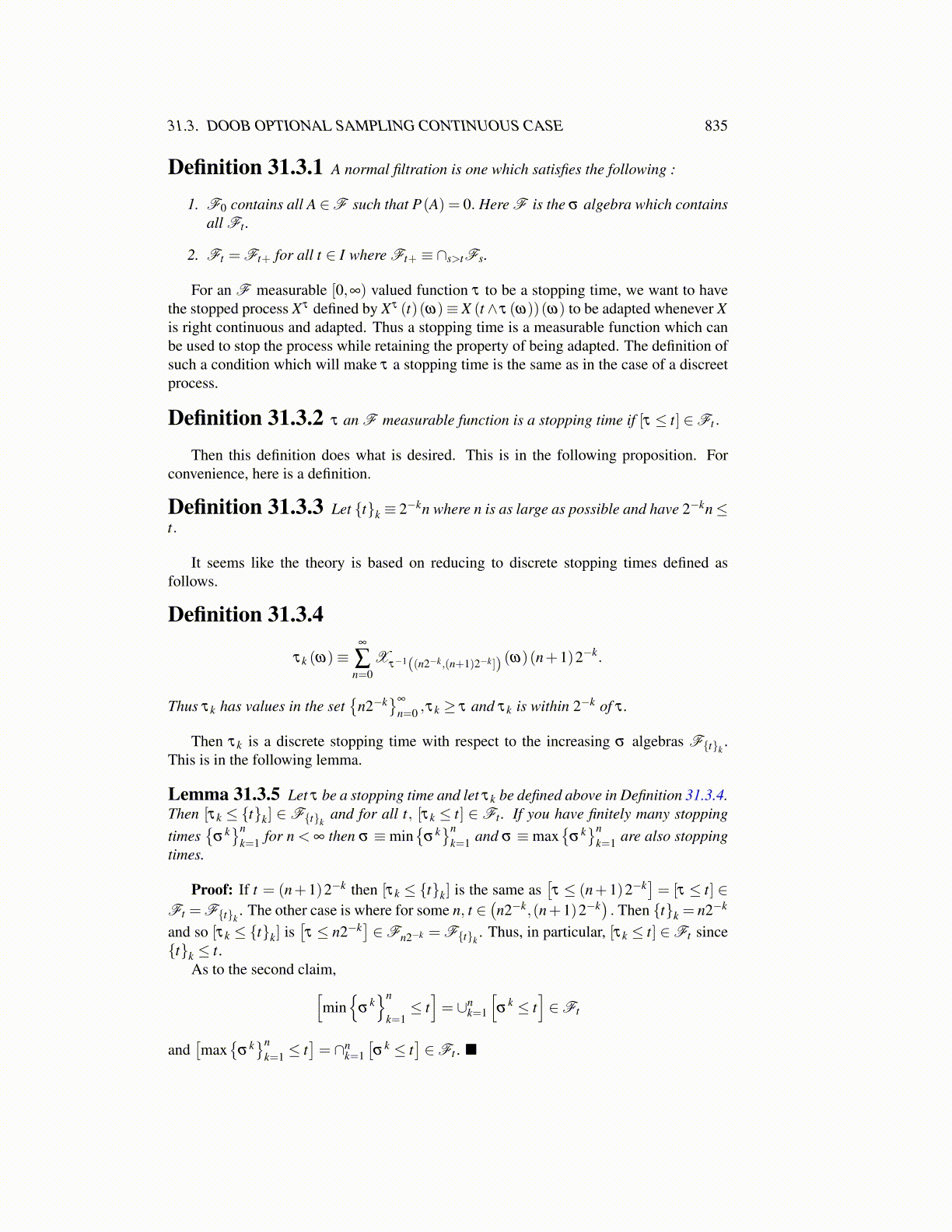
31.3. DOOB OPTIONAL SAMPLING CONTINUOUS CASE 835
Definition 31.3.1 A normal filtration is one which satisfies the following :
1. F0 contains all A ∈F such that P(A) = 0. Here F is the σ algebra which containsall Ft .
2. Ft = Ft+ for all t ∈ I where Ft+ ≡ ∩s>tFs.
For an F measurable [0,∞) valued function τ to be a stopping time, we want to havethe stopped process Xτ defined by Xτ (t)(ω)≡ X (t ∧ τ (ω))(ω) to be adapted whenever Xis right continuous and adapted. Thus a stopping time is a measurable function which canbe used to stop the process while retaining the property of being adapted. The definition ofsuch a condition which will make τ a stopping time is the same as in the case of a discreetprocess.
Definition 31.3.2 τ an F measurable function is a stopping time if [τ ≤ t] ∈Ft .
Then this definition does what is desired. This is in the following proposition. Forconvenience, here is a definition.
Definition 31.3.3 Let {t}k ≡ 2−kn where n is as large as possible and have 2−kn≤t.
It seems like the theory is based on reducing to discrete stopping times defined asfollows.
Definition 31.3.4
τk (ω)≡∞
∑n=0
Xτ−1((n2−k,(n+1)2−k]) (ω)(n+1)2−k.
Thus τk has values in the set{
n2−k}∞
n=0 ,τk ≥ τ and τk is within 2−k of τ .
Then τk is a discrete stopping time with respect to the increasing σ algebras F{t}k .This is in the following lemma.
Lemma 31.3.5 Let τ be a stopping time and let τk be defined above in Definition 31.3.4.Then [τk ≤ {t}k] ∈F{t}k and for all t, [τk ≤ t] ∈Ft . If you have finitely many stoppingtimes
{σ k}n
k=1 for n < ∞ then σ ≡min{
σ k}n
k=1 and σ ≡max{
σ k}n
k=1 are also stoppingtimes.
Proof: If t = (n+1)2−k then [τk ≤ {t}k] is the same as[τ ≤ (n+1)2−k
]= [τ ≤ t] ∈
Ft =F{t}k . The other case is where for some n, t ∈(n2−k,(n+1)2−k
). Then {t}k = n2−k
and so [τk ≤ {t}k] is[τ ≤ n2−k
]∈Fn2−k = F{t}k . Thus, in particular, [τk ≤ t] ∈Ft since
{t}k ≤ t.As to the second claim,[
min{
σk}n
k=1≤ t]= ∪n
k=1
[σ
k ≤ t]∈Ft
and[max
{σ k}n
k=1 ≤ t]= ∩n
k=1
[σ k ≤ t
]∈Ft . ■